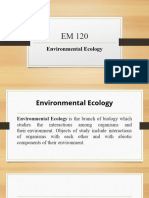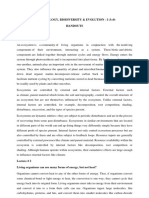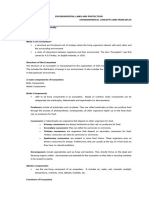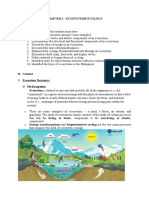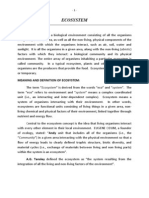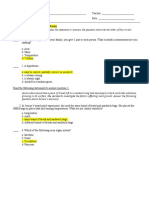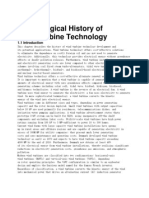0 ratings0% found this document useful (0 votes)
14 viewsFirst and Second Lectures of Ecosystem
First and Second Lectures of Ecosystem
Uploaded by
Aya DawoodCopyright:
© All Rights Reserved
Available Formats
Download as PDF, TXT or read online from Scribd
First and Second Lectures of Ecosystem
First and Second Lectures of Ecosystem
Uploaded by
Aya Dawood0 ratings0% found this document useful (0 votes)
14 views23 pagesCopyright
© © All Rights Reserved
Available Formats
PDF, TXT or read online from Scribd
Share this document
Did you find this document useful?
Is this content inappropriate?
Copyright:
© All Rights Reserved
Available Formats
Download as PDF, TXT or read online from Scribd
Download as pdf or txt
0 ratings0% found this document useful (0 votes)
14 views23 pagesFirst and Second Lectures of Ecosystem
First and Second Lectures of Ecosystem
Uploaded by
Aya DawoodCopyright:
© All Rights Reserved
Available Formats
Download as PDF, TXT or read online from Scribd
Download as pdf or txt
You are on page 1of 23
Course: Ecosystem
المستوي الرابع :كيمياء/نبات الئحة جديدة
المستوي الرابع :ميكروبيولجي الئحة جديدة
استاذ المادة :مها محمد الشامي
استاذ البيئة النباتية المساعد
قسم النبات علوم المنصورة
Ecosystem Definition
An ecosystem is a system consisting of biotic and abiotic
components that function together as a unit. The biotic
components include all the living things whereas the abiotic
components are the non-living things. Thus, an ecosystem
science definition entails an ecological community consisting of
different populations of organisms that live together in a
particular habitat. Natural sciences like ecology and geography
define an ecosystem as a geographic area where organisms,
weather, and landscape, work together to form a “bubble.
How about in biology, what is an ecosystem? In essence, the
ecosystem definition in biology is that it acts as the
fundamental unit of nature. Just as a living organism is made
up of cells that act as the structural and functional units of life,
nature also consists of fundamental units called ecosystems.
Ecosystem Definition
An ecosystem is a system consisting of biotic and abiotic components
What is a simple definition of an ecosystem?
An ecosystem is a community plus the environment. Ecology, which is the
scientific study of the interactions between populations or between
organisms and the environment, can be viewed at the level of an individual,
a population, a community, or an ecosystem.
• Ecology at the level of individuals is concerned chiefly with the individual
organism’s physiology, reproduction, and development. At the level of
population, ecology deals primarily with the attributes and the various
factors affecting the population. At the level of community, ecology
studies the interactions between populations and community patterns. At
the level of an ecosystem, ecology puts all of them together to understand
how the system operates as a unit. Thus, an ecosystem ecology would be
more concerned about energy flow and nutrient cycles than about
individual species.
The term was coined in the early 1930s by the botanist, Roy Clapham, to
denote the physical and biological components of an environment.
However, it was the British Ecologist, Arthur Tansley, who first introduced
the concept: “The Use and Abuse of Vegetational Concepts”.
Synonyms: environs; ecological community.
Levels of Organization for Ecosystem
Another definition for Ecosystem
An ecosystem is a geographic area where plants, animals, and
other organisms, as well as weather and landscape, work
together to form a bubble of life. Bison are a keystone species
of the tall-grass prairie ecosystem of the Great Plains of the
United States and Canada.
Two components of the ecosystem: Biotic and
Abiotic
(1) Biotic components
The biotic components include all the living things. Basically, there are two major
types of living things. They are the eukaryotes and the prokaryotes. Eukaryotes are
characterized by having membrane-bound organelles (such as a nucleus) inside their
cells. The prokaryotes, in turn, are those lacking membrane- bound organelles.
Examples of eukaryotes are plants, animals, fungi, and protests. Bacteria,
cyanobacteria, rickettsia represent the prokaryotes.
Plants, for instance, have chloroplasts that enable them to harvest light energy.
Then, they take carbon dioxide and water from their environment to convert them
into sugar, a biomolecule that can be used to synthesize chemical energy (such as
ATP). Because they are capable of producing their own food through photosynthesis,
they are referred to as the Producers. Next to the producers are the primary
consumers. They feed on the producers while they serve as a food source to the
higher levels of consumers (e.g. secondary and tertiary).
The animals are examples of consumers. The animals that feed on plants are
called herbivores whereas those that feed on other animals are carnivores. Then,
there are those that feed on both plants and animals. They are called omnivores
Biotic components include
1-Producers: (auto-trophies)
Producers are the source of all food in an ecosystem.
-On land: green plants
- algae at Fresh water and reed swamps
-Sea phytoplankton
-Macroalgae
-Cyanobacteria
(Photosynthesis + Chemosynthesis)
2-Consumers:
• 1-Primary consumers (herbivorous)
• 2-Secondary consumers (carnivorous)
• 3-Tertiary consumers (large carnivorous)
• 4-Omniverous (mixed diet)
3- Decomposers: mostly certain types of bacteria & Fungi
4-Detritiovres: live on all detritus, parts of dead organisms.
Detritivores
Detritivores are heterotrophs that obtain nutrients by
consuming detritus. There are many kinds of invertebrates,
vertebrates and plants. By doing so, all these detritivores
contribute to decomposition and the nutrient cycles.
Detritivores هي كائنات غيرية التغذية تحصل على العناصر الغذائية عن
.طريق استهالك المخلفات
1) Biotic components(food chain)
(2) Abiotic components
The abiotic components include all the non-living things,
such as rocks, soil, minerals, water sources, and the local
atmosphere. The abiotic components also have their
ecological role. For example, elements and compounds serve
as sources of nutrients. They are essential to the growth and
metabolism of an organism. Apart from providing nutrients,
they also provide organisms a place to live and thrive —
a habitat.
Abiotic components include
1-Atmosphere which consists of:
1-Nitrogen gas 78.08%
2-Oxygen gas 20.95%
3-Argon 0.93%
4-Carbon oxide 0.03%
5-Traces of hydrogen gas, helium, krypton, zynon, ozone, methane
2-Climatic factors
Include light, temperature, precipitation, winds, humidity, evaporation etc.
3-Edaphic factors
It includes soil texture, organic matter in soil, soil reaction (pH), minerals, etc.
4-Water bodies
• It includes water pH, salinity, light, oxygen, depth, tidal, nutrients, etc.
5-Physiographic factors (topography)
It includes the structure and behavior of the earth's surface, such as: elevation,
wadis, slopes, exposure, etc.
Kinds of organism's interactions
The biotic and the abiotic components interact with one
another as a system and are linked to one another via
nutrient cycles and energy flows. For instance, energy
and nutrients enter the system via the photoautotrophs.
They are organisms that carry out photosynthesis, such
as plants and green algae. Then, the heterotrophs, for
example, animals, feed on the photoautotrophs. This
makes the energy and the nutrients move through the
system. The death of these organisms incites
decomposition by the decomposers. This process
releases the nutrients back to the environment to be re-
used by the organisms.
Kinds of organism's interactions (1)
1- Predation &Competition
2-Commensalism
3-Parasitism
4-Symbiosis (Mutualism)
5-Alleopathy (Amensalism)
1-Competition and Predation
When one entity hunts another animal to suffice its
nutritional requirements, it is referred to as predation. A
predator is an entity that hunts its prey. For example, a
snake eats a frog and carnivorous plants eat insects.
Competition, on the other hand, is when populations or
even an individual compete for food resources. It is often
referred to as exploitative or consumptive competition.
Kinds of Organism's interactions (2)
2-Commensalism
It is an imbalanced type of interaction wherein one entity
benefits while the other is neither harmed nor benefited.
For example: Metabiosis – One entity is dependent on the
other for survival example: Epiphytes.
3-Parasitism
One entity benefits from other entities and they harmed,
but not necessarily killed. The entity that is harmed is the
host and the one benefited is the parasite. When the host
is killed, this type of behavior is referred to as
parasitoidism. These parasites can be living on the surface
of the host, often addressed as ectoparasites, while
endoparasites live inside the host( هالوك الفول وحامول
)البرسيم.
Kinds of organism's interactions (3)
4-Mutualism(Symbiosis)
• Both species involved in the interaction are benefited. These
interactions take place in three patterns:
• a- Facultative mutualism – Species survive on their own under
favorable conditions
• b-Obligate mutualism – One species is dependent for survival on
the other (Lichens)
• c-Diffusive mutualism – One entity can live with multiple partners
• These relationships have three purposes:
5-Amensalism(Alleopathy)
• In this type of interaction, when one population finds itself in
danger the other population is not majorly affected. For instance,
Tall and wide plants hinder the growth of comparatively smaller
plants. Some plants even secrete substances that repress the
growth of nearby plants in order to remove competition.
•
Food Chain and Food Webs
• The movement of energy and organic matter
(nutrients) from one organism to another makes up
a food chain. A typical food chain in a grassland
might move from grasses (producer) to rabbits
(primary consumers that eat grasses) to snakes
(secondary consumers that eat rabbits) to hawks
(tertiary consumers that eat snakes). Ecosystems
contain many food chains that overlap and
interconnect to form a food web.
A food chain & a food web
Organisms in a community are linked through what they eat
and what eats them. A food chain is a single pathway
connecting a producer with several levels of consumers. In a
typical marine food chain, dinoflagellates convert energy from
sunlight into food through photosynthesis and store it in their
tissues. Copepods feed on dinoflagellates and incorporate this
energy into their own tissues. The energy is transferred to
sunfish when they feed on copepods, to small sharks that feed
on sunfish, and to large sharks that feed on small sharks. The
feeding relationships in an ecosystem consist of many food
chains interconnected into a network called a food web.
To learn more about this, proceed to: Processes
of the Ecosystem.
The biotic and abiotic components can also serve as environmental
(ecological) factors that affect the ecosystem. The biotic components whose
biological activity creates an impact in the ecosystem are referred to as
the biotic factors. The abiotic factors, in turn, include the non-living things
and the physical aspects of an ecosystem, such as climate, temperature, and
pH.
An example of a biotic factor is the extent of predation in an ecosystem. If
there is an increase in the number of predators, predation activity would
likely increase. This, in turn, could significantly lessen the population
density of their prey. If their prey is a key species, meaning another group of
organisms depends on them for survival, then the decline (or worse, the
extinction) of these key species could also lead to the decline (or worse, the
extinction) of the organisms relying upon them.
As for the abiotic factor, they can regulate the size or the density of a
species population. For instance, acid rain, which is unusually acidic
precipitation and has high levels of hydrogen ions, can produce detrimental
effects to the soil (e.g. leaching) as well as to the plants and aquatic animals
that are sensitive to low pH.
Pyramid Number of individuals
You might also like
- Ernst Mayr One Long Argument PDFDocument2 pagesErnst Mayr One Long Argument PDFDanNo ratings yet
- Ecology Notes!!Document10 pagesEcology Notes!!Raudha Athif100% (3)
- BCIL Tzed Homes Case StudyDocument3 pagesBCIL Tzed Homes Case StudyShubham Udoshi100% (1)
- All Lectures of Ecosystem 2022 and 2023Document117 pagesAll Lectures of Ecosystem 2022 and 2023Aya DawoodNo ratings yet
- EcosystemDocument9 pagesEcosystemLeo JacobNo ratings yet
- Roots Degree College I Semester 2023 Environmental Science: Unit - I: Ecosystem, Biodiversity & Natural ResourcesDocument23 pagesRoots Degree College I Semester 2023 Environmental Science: Unit - I: Ecosystem, Biodiversity & Natural ResourcesGopi KrishnaNo ratings yet
- GEL 2 (Task2) MidtermDocument6 pagesGEL 2 (Task2) MidtermBethwen Eliza CDichosoNo ratings yet
- EcologyDocument18 pagesEcologyharshbaghel8349No ratings yet
- EcosystemDocument10 pagesEcosystemAšïm JĂñ ĀlbalosHiNo ratings yet
- CPE214, ProgrammingDocument9 pagesCPE214, ProgrammingjmarmoniogarciaNo ratings yet
- Environment ManagementDocument32 pagesEnvironment ManagementNavdeep NegiNo ratings yet
- Introduction To Environmental EcologyDocument19 pagesIntroduction To Environmental EcologyDivina Valdez Alisoso RafaelNo ratings yet
- Ecosystem PPT 735Document100 pagesEcosystem PPT 735Pauldavid SelsonNo ratings yet
- Module - III-Ecosystem NotesDocument100 pagesModule - III-Ecosystem Notesdellaishere03No ratings yet
- Ecosystem RevisedDocument100 pagesEcosystem RevisedAlonafe TevesNo ratings yet
- Unit 2 EcosystemDocument91 pagesUnit 2 EcosystemJane AlamNo ratings yet
- EcosystemDocument7 pagesEcosystemHafiz Khalil ahmad nooraniNo ratings yet
- Principles and Concept of EcosystemDocument16 pagesPrinciples and Concept of EcosystemJay Bianca Abera Alistado100% (1)
- Ecosystem New 2017Document20 pagesEcosystem New 2017raniNo ratings yet
- Our Environment Notes 1Document9 pagesOur Environment Notes 1Kanishka ChauhanNo ratings yet
- Ecology 1Document14 pagesEcology 1Cowboy XxNo ratings yet
- People and The Earths Ecosystem CoverageDocument49 pagesPeople and The Earths Ecosystem CoverageChristen Honely DadangNo ratings yet
- Environment IDocument14 pagesEnvironment I9921005047No ratings yet
- The Science of EcologyDocument2 pagesThe Science of EcologybluepixarlampNo ratings yet
- Est MicroprojectDocument8 pagesEst Microprojectjayeshbaviskar9501No ratings yet
- Environment Paloma BSPDocument17 pagesEnvironment Paloma BSPJosh Sebastian LabraNo ratings yet
- Components of An EcosystemDocument31 pagesComponents of An Ecosystemksbbs100% (1)
- EVS - Unit-1 (Notes)Document51 pagesEVS - Unit-1 (Notes)Saksham AroraNo ratings yet
- Amity Ecosystems Why So DumbDocument24 pagesAmity Ecosystems Why So Dumbwasid25897No ratings yet
- Lecture 2 EcosystemDocument19 pagesLecture 2 EcosystemParva PatelNo ratings yet
- SUSTAINABILITY OF ENVIRONMENT - WatermarkDocument12 pagesSUSTAINABILITY OF ENVIRONMENT - WatermarkHardik ChauhanNo ratings yet
- BT101 Updated HandoutsDocument212 pagesBT101 Updated Handoutsahseera2005No ratings yet
- Manual Environmental Laws 1Document25 pagesManual Environmental Laws 1maiquezjestNo ratings yet
- Our EnvironmentDocument9 pagesOur EnvironmenthafsaNo ratings yet
- ESDM Unit I BSs EcosystemsDocument87 pagesESDM Unit I BSs EcosystemsMuthuraman ArNo ratings yet
- Ecology and Its BranchesDocument13 pagesEcology and Its BranchesMahaize TayawaNo ratings yet
- Environmental StudiesDocument67 pagesEnvironmental Studiesshu100% (1)
- Chapter 2 EcosystemDocument6 pagesChapter 2 EcosystemNitish BarmanNo ratings yet
- EVS CHAP 2 EcosystemDocument105 pagesEVS CHAP 2 EcosystemNida KhanNo ratings yet
- Environmental DisatersDocument300 pagesEnvironmental DisatersFaith RiderNo ratings yet
- Science of EcologyDocument2 pagesScience of Ecologyhomamunfat100% (1)
- Unit IIDocument46 pagesUnit IIAnonymous fbUJwFVPNo ratings yet
- BIO 101 Interrelationshp Among OrganismsDocument13 pagesBIO 101 Interrelationshp Among OrganismsbravadoNo ratings yet
- Ecosystem NotesDocument11 pagesEcosystem Notesluciferx187No ratings yet
- Biology - Patterns in Nature NotesDocument5 pagesBiology - Patterns in Nature NotesbigscribdfanNo ratings yet
- 2 EcosystemsDocument68 pages2 EcosystemsSanjana SNo ratings yet
- DocumentDocument6 pagesDocumentharshbaghel8349No ratings yet
- EcosystemDocument8 pagesEcosystemKhushi SalgaonkarNo ratings yet
- Ecosyste 1Document8 pagesEcosyste 1mugishablessoceaneNo ratings yet
- EcosystemDocument7 pagesEcosystemHamza Khan100% (1)
- Module 1.1 Ecosystem ConceptsDocument27 pagesModule 1.1 Ecosystem ConceptsFrizza LynNo ratings yet
- Chapter 2 - Ecosystems Ecology A. Learning ObjectivesDocument23 pagesChapter 2 - Ecosystems Ecology A. Learning ObjectivesMarel Bonna E. QuipanesNo ratings yet
- Lesson 9 - Biotic Components of An EcosystemDocument3 pagesLesson 9 - Biotic Components of An EcosystemAbegail HernandezNo ratings yet
- Reviewer in Ge10Document13 pagesReviewer in Ge10Rej AgustinNo ratings yet
- EcosystemDocument25 pagesEcosystemSoumya RanjanNo ratings yet
- Eco System (Environmental Science)Document29 pagesEco System (Environmental Science)siva_j_1No ratings yet
- Ecosystem - Concept Structure and FunctionsDocument5 pagesEcosystem - Concept Structure and FunctionsTusshar Pradhan100% (1)
- Ecology DiscussionDocument31 pagesEcology DiscussionAl Marjorie Abrasaldo TatingNo ratings yet
- Ecology & EcosystemsDocument15 pagesEcology & EcosystemsRobert Malusher MwandoeNo ratings yet
- Ecosystems: All The Living and Non-Living Factors of The Environment". Various Ecologists Have Added MuchDocument34 pagesEcosystems: All The Living and Non-Living Factors of The Environment". Various Ecologists Have Added MuchTEJAS .M.S.No ratings yet
- How Does the Food Chain Work? - Science Book for Kids 9-12 | Children's Science & Nature BooksFrom EverandHow Does the Food Chain Work? - Science Book for Kids 9-12 | Children's Science & Nature BooksNo ratings yet
- Renewable Energy: Brian Snyder, Mark J. KaiserDocument12 pagesRenewable Energy: Brian Snyder, Mark J. KaiserAkshat SinghNo ratings yet
- Bio-Climatic Tower/Eco-Tower: Bachelor of ArchitectureDocument12 pagesBio-Climatic Tower/Eco-Tower: Bachelor of ArchitectureZorawar Singh Basur67% (3)
- Annotated Bibliography - Alex ByerlyDocument5 pagesAnnotated Bibliography - Alex Byerlyapi-404811976No ratings yet
- 8 ThermoformingDocument32 pages8 ThermoformingGuru RaghavendraNo ratings yet
- Green: A Seminar Report OnDocument29 pagesGreen: A Seminar Report OnManish kumarNo ratings yet
- Durag High Energy Spark Igniter (D-HG 400)Document2 pagesDurag High Energy Spark Igniter (D-HG 400)senthilrsenthilNo ratings yet
- Condenser - Valuable Book PDFDocument6 pagesCondenser - Valuable Book PDFRajesh Owaiyar100% (1)
- Mind Mapping 9 Satria Krisnanda PDFDocument1 pageMind Mapping 9 Satria Krisnanda PDFMade Satria Krisnanda PujawanNo ratings yet
- Trụ sở: 28N7A dãy 2 đường Nguyễn Thị Thập, Q. Thanh Xuân, Hà Nội. Hotline: 090 240 8989Document8 pagesTrụ sở: 28N7A dãy 2 đường Nguyễn Thị Thập, Q. Thanh Xuân, Hà Nội. Hotline: 090 240 8989Phong Pham TueNo ratings yet
- Inter Specific InteractionDocument7 pagesInter Specific InteractionSandeep kumar SathuaNo ratings yet
- Atlas of Namibia - 03 ClimateDocument36 pagesAtlas of Namibia - 03 ClimateCesar Ricardo Lopez ValerioNo ratings yet
- 7th Grade Pretest and KeyDocument8 pages7th Grade Pretest and Keyapi-377802356No ratings yet
- Assessment of Solar and Wind Resource Synergy in AustraliaDocument14 pagesAssessment of Solar and Wind Resource Synergy in AustraliaEbub eNo ratings yet
- Clarification Response PDFDocument2 pagesClarification Response PDFArunNo ratings yet
- Chronological History of Wind Turbine TechnologyDocument2 pagesChronological History of Wind Turbine TechnologyDeepak AshokanNo ratings yet
- Thermodynamics One Word Interview Questions and Answers PDF - Mechanical Engineering Questions and AnswersDocument3 pagesThermodynamics One Word Interview Questions and Answers PDF - Mechanical Engineering Questions and AnswersS Sweet SweetNo ratings yet
- Atoms Elements and Compounds WorksheetDocument2 pagesAtoms Elements and Compounds WorksheetNubar MammadovaNo ratings yet
- Gas DiffusionDocument10 pagesGas DiffusionFunsho OlorunyomiNo ratings yet
- Iteh Standard Preview (Standards - Iteh.ai) : SIST EN 837-1:1997 Slovenski StandardDocument13 pagesIteh Standard Preview (Standards - Iteh.ai) : SIST EN 837-1:1997 Slovenski StandardJAMSHIL.T JjNo ratings yet
- MAG LEVintroductionDocument3 pagesMAG LEVintroductionlance galorportNo ratings yet
- Task 1. Look at The Pictures and Complete The Blanks With The Words GivenDocument5 pagesTask 1. Look at The Pictures and Complete The Blanks With The Words GivenLê Tường VyNo ratings yet
- Rohini 34950090004Document11 pagesRohini 34950090004varalakshmiakash2712No ratings yet
- Why Do We Need To Study Thermodynamics?Document15 pagesWhy Do We Need To Study Thermodynamics?BalvinderNo ratings yet
- s21 s22 s36 s47 s64Document2 pagess21 s22 s36 s47 s64hyreepktNo ratings yet
- Module 8.1 Electricity and MagnetismDocument22 pagesModule 8.1 Electricity and MagnetismHinata ShoyoNo ratings yet
- HOTS Chapter 3 Form 4Document4 pagesHOTS Chapter 3 Form 4HawaNo ratings yet
- T-Xy Diagram For ETHAN-01/WATER: X 560,0 MM HGDocument2 pagesT-Xy Diagram For ETHAN-01/WATER: X 560,0 MM HGsergioln001No ratings yet
- Spacial Relativity McqsDocument14 pagesSpacial Relativity McqsMuhammad Noman Hameed100% (1)











